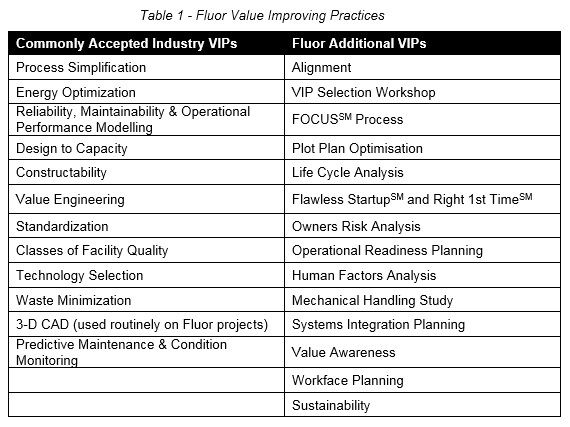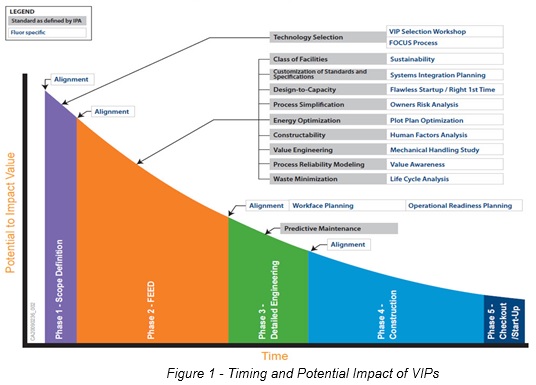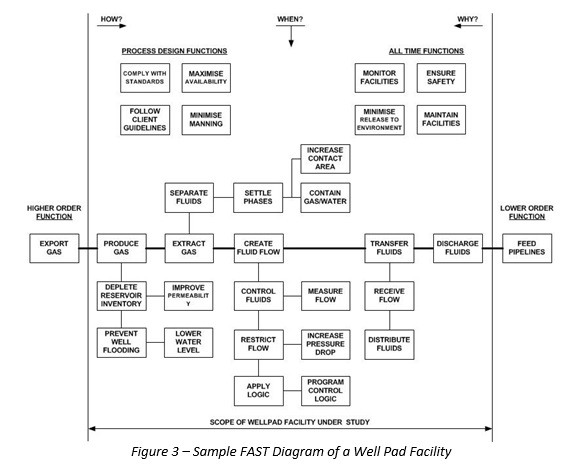By Behnam Bashokooh, CEng, AVS and Hans Göebel, PhD
Projects in the area of energy and chemicals cover a range from small maintenance projects to the largest and most capital-intense projects in industry. Especially for the larger projects, which can involve investments of several billions of dollars, the use of value improving practices has become common practice and contributes to successful execution and significant cost savings.
In this paper, some experiences are shared from projects executed by Fluor Corporation. Fluor Corporation is one of the largest engineering, procurement, construction (EPC), maintenance, and project management companies in the world. Fluor works with governments and clients in diverse industries around the world to design, construct, and maintain complex and challenging capital projects. Within Fluor, Value Improving Practices are a standard and mandatory tool for use in all projects.
Life-cycle of Large-Scale Energy and Chemicals Projects
In the execution of energy and chemicals projects, usually the following phases are distinguished:
- Front End Engineering
- Detailed Engineering and Procurement
- Construction and Startup
- Operation and Maintenance
During the Front End phase, the scope definition of the project takes place, starting with feasibility studies, siting studies and evaluations of different technologies and licensors. When a first definition is completed, a conceptual design is made, including a first cost estimate.
If the business case for the project is confirmed, a basic design is performed including computer simulations of the different operating scenarios of the plant, sizing of major equipment, an initial layout of the plant, etc. The result of this phase is usually called the FEED (Front End Engineering and Design) package. At this stage, again a cost estimate is made, and the business case is again verified.
During the next phase, detailed engineering of the equipment, piping and all other components of the facility is done, up to a level where materials and equipment can be procured from the market. Because of the size and special requirements of these projects, procurement in most cases is done on a global scale, where specialised equipment may come from the other side of the globe.
During the construction phase, the procured materials are brought to the site of the new facility, and build together. More and more also the concept of modularization is used, where large sections of a plant are constructed at specialised construction yards and are brought to the plant site as pre-build modules.
After the mechanical completion of the plant, it is started up and operated by the owner. During operation, modification projects and maintenance activities will continue.
During the execution lifetime of a project, the level of detail of the work increases from a very high level (say at a unit level) to a very low level (literally up till nuts and bolts). At the same time, the room to change the projects becomes smaller and smaller. During the initial phases it is relatively easy to make major modifications (e.g. changes in the design capacity, use other technologies, and so forth), but in later stages, every change will lead to significant rework, delays and potential cost increase.
Fluor Value Improvement Practices
Major projects in energy and chemicals industry make increasing use of a range of formal reviews and creative processes during the development and implementation stages that have been shown to improve the chances of achieving a successful outcome. These studies are known in the industry as Value Improving Practices.
Value Improving Practices (VIPs) are out-of-the-ordinary studies and evaluations involving a work process that are used to enhance the project outcomes, e.g. cost, schedule, safety, operability, reliability, and so forth. VIPs are formal, documented practices applied in a systematic approach by project teams. They are implemented using a standard work process and methodology that allows them to be consistent and repeatable from project to project.
Many of Fluor’s clients subscribe to Independent Project Analysis Inc. (IPA), a superior and highly respected consultancy in project evaluation and project system benchmarking. IPA promotes the application of VIPs on projects as a way to improve the project outcomes, and as such, Fluor clients often mention value improving practices in the goals and objectives of capital projects. There is a trend among clients to require value improving practices in design documentation.
IPA lists 12 commonly accepted value improving practices including Value Engineering that have demonstrated a reliable connection between their use and better outcomes of projects. In addition to these, Fluor has 14 additional VIPs that may be incorporated into a Project VIP program. These practices are listed in the table below:

Fluor VIPs cover a comprehensive range of aspects of capital projects and facilities, from optimising the design criteria and standards at the start of the project life cycle to operational readiness planning for the commissioning and operation at the end of construction. To name a few, Alignment and VIP Selection Workshop VIPs focus on defining the project execution strategy, project objectives and team responsibilities, as well as the facilitated value improving efforts that should happen performed at different stages during the project to support project goals. VIPs like Technology Selection, Process Simplification and Energy Optimisation are conducted during the early design stage to optimise the facilities life cycle cost and investment requirements while satisfying the project objectives. On the other hand, some VIPs focus on certain elements of the project like construction, integration and operation, for example, Constructability, System Integration Planning, Operational Readiness Planning and Predictive Maintenance VIPs.
As an example, Classes of Plant Quality VIP is performed at the start of most projects. It has shown to be an excellent process for alignment of client expectations and contractor execution. In a particular case where the client was a consortium of several companies, it also helped to align the expectations of the different client organisations. In some cases, it is directly followed by a Design to Capacity value improvement workshop to discuss in more detail the necessary design capacity of different sections of a project.
Several projects in Fluor have successfully performed Waste Minimization VIP studies where all the waste streams from a process were systematically analysed, and possibilities for reduction and reuse were investigated.
Value Engineering workshops are being held in different phases of projects and can vary significantly in scope and duration. In some cases the workshop is only used to generate ideas that are further developed later in the project; in some cases, initial development and first cost estimate are done already in the workshop. Fluor has executed these workshops on many of its in-house projects, ranging from small expansion projects with only a few pieces of equipment to large projects like complete new refinery units, offshore facilities and power stations. In some cases, Fluor provided its Value Engineering expertise to clients for other projects in the organisation.
VIPs are almost always facilitated by specialists from outside the project design team to enhance the structure of the studies and ensure the integrity of the process. Depending on the VIP, the study team is set up in a way to ensure comprehensive coverage of all the relevant area of the project and the required knowledge and experience, from business vision to engineering, construction and operation.
VIPs Applicable to Different Stages of Projects
The influence of value improving practices and the value they generate is the highest during the Front-end Engineering and Design (FEED) phase of the projects when various aspects of the facilities are under development and design and the cost to carry out any changes in the design is not substantial. For this reason, many of the VIPs should ideally be conducted in the early stages of the project, during Concept Design / Scope Definition and FEED phases. Missing the suitable time in the life cycle of the project will reduce the benefits of the VIPs and limit their application due to the rise of the cost of late changes on the project diminishing the observable gains from improvements.
On the other hand, some of the VIPs, for example, Workface Planning, Operational Readiness Planning and Predictive Maintenance need more detailed and advanced information from the design of the facilities that should be performed during the later stages of the design. Furthermore, some VIPs may be used in different phases of the projects as appropriate within the specific project needs and requirements.
Figure 1 shows the applicability of the different VIPs through the timeline of a capital project, as well as the trend of the potential impact of the VIPs through the project life cycle.

Application of VE in projects as an example of use of VIPs
In the current state of world economy, the oil and gas industry faces significant decreases in cash flow and profits due to for example low oil prices and supply/demand imbalance. Because of this, new projects are under significant pressure to maximise the Value to clients, often focusing on improving project economics and reducing costs. In the context of Value Engineering and Value Management, Value is defined as the relationship between the satisfaction of needs and the resources used in achieving that satisfaction (Ref. BS EN 1325-1 and BS EN 12973):

SAVE International defines Value as the Resources required to accomplish a certain Function. SAVE defines Needs as the necessary Functions that are important for stakeholders and should be satisfied:

Defining Value in these forms helps us measure and quantify it and find different ways to improve it. It gives us a mathematical parameter that is measurable and index-able. It provides us with a basis to determine and quantify Value in some way, to evaluate whether a change is making real and objective improvements in the value. From the definitions above, we can see that improving Value is actually in finding the balance in the amount of resource that we spend to satisfy our needs, not in just reducing the use of resources, not just Cost Cutting. Moreover, to improve Value, it is important to understand clearly and deeply what Needs we should satisfy. Stakeholders Needs and product Functions are the primary focus in the Value Management and Value Engineering (VE) methodologies, and we spend a big part of any Value Improving Practice workshop identifying and understanding them.
As Value Engineering is defined as a VIP, many project teams consider VE as a cost-cutting technique to reduce the capital and operating cost of projects and facilities, as well as project execution expenses. However, VE can be applied at different stages of the project to improve the value of the project and solve the challenges the project team face like procedures and processes, schedule, plant configuration, material optimisation, safety, operability, or life-cycle cost, to name a few. For example, to identify the optimum configuration for a processing facility, FAST diagrams and Function Flow Diagrams are used to specify the functions required to process the feedstock, functions costing is performed to determine the critical functions to focus on, and creativity and brainstorming phase is used to identify solutions to satisfy the functions in a more cost effective way. Figure 2 provides an example of a block flow diagram of a gas processing facility, where each processing block is presented as a Function (active verb + measurable noun) to enable the team to evaluate the required processing functions in the facility and brainstorm solutions to satisfy these functions through different processes and technologies.

FAST diagrams and Value Methodology Work Plan are also used to determine the project execution functions and come up with ways to improve the project performance and maximise the value observed. For example, a project schedule is based on a logical flow of activities and therefore is amenable to treatment using a FAST diagram approach. Each activity can be considered a Function with a cost, which is effectively “negative float”. The goal of the VE study is to maximise is the float in the critical path to give the project more flexibility and freedom, reduce the risk of schedule over-run or cost saving in case the schedule can be shortened. The VE workshop evaluates where the lowest value exists, and which functions can have their value improved.
The same approach is used in safety and operability evaluations, to identify the alternative solutions that can improve the design while ensuring that all the critical functions are properly satisfied. Figure 3 provides the FAST diagram of a Wellpad Facility that was developed during a Value Engineering workshop tasked to develop the most optimum solution for a standard well pad to be installed on thousands of unconventional gas wells on one of Fluor’s major projects. Two of the critical challenges for the design were the need for remote operation of well pads during normal operation and the safety of local operators during commissioning and startup scenarios.

Apart from using VE for improving project outcomes, Fluor is also applying Value Methodology to evaluate its corporate level business operations to maximise the value of the efforts in the company. As an example, Fluor knowledge management team has recently used Value Engineering and FAST diagramming to identify the functions needed for the flow of knowledge across the different stakeholders of information, evaluate the level of satisfaction of these function in the company, and identify the ways to improve the quality of the satisfaction of these functions as well as improve the cost of operation in the company.
Although Value Engineering of a project scope or facility by itself is a VIP, Value Engineering framework and technique can also make a significant contribution to the performance and success of other VIPs. Following a Value Methodology Work Plan through the practices ensures the teams spend adequate time during the Information phase to understand the problem, the stakeholder’s needs and limitations, as well as internal and external risks and opportunities. Furthermore, focusing on Functions and developing FAST Diagrams help the project teams focus their attention on the functions instead of tools, evaluate the problems in a more holistic and detailed level, and brainstorm all the possible options to improve the value of the projects.
About the Authors
Behnam Bashokooh is a Value Management Specialist and a Process Engineer with 11 years industry experience in the energy and chemicals industry. Working from the Fluor office in Farnborough, United Kingdom, he is responsible for facilitating Value Improvement Practices in various projects across Fluor offices. He also develops and conducts Value Management training throughout the company, and is involved in establishing and implementing Fluor’s strategy towards value management.
Hans Göebel is a Technical Director and Senior Fellow working for over 25 years for Fluor Corporation. Working from the Fluor office in Amsterdam, The Netherlands, he is responsible for technological project support in the areas of process simulation, thermodynamic data and process engineering software tools in general. He is also active in organising and facilitating Value Improvement workshops and HAZOP reviews on projects throughout the company.
